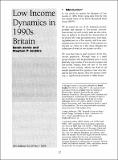| dc.contributor.author | Jarvis, Sarah | en |
| dc.contributor.author | Jenkins, Stephen P | en |
| dc.date.accessioned | 2016-02-24T15:14:11Z | |
| dc.date.available | 2016-02-24T15:14:11Z | |
| dc.date.issued | 01/01/1998 | en |
| dc.identifier.citation | Jarvis, S. and Jenkins, S., P (1998) Low Income Dynamics in 1990s Britain. IDS Bulletin 29(1): 32-41 | en |
| dc.identifier.issn | 1759-5436 | en |
| dc.identifier.uri | https://opendocs.ids.ac.uk/opendocs/handle/20.500.12413/9182 | |
| dc.description.abstract | Summary This article analyses low income dynamics in Britain using the first four waves of the British Household Panel Survey. There is much low income turnover; although there is a small group of people who are persistently poor, more striking is the relatively large number of low income escapers and entrants from one year to the next. Simulations using estimated low income exit and re?entry rates demonstrate the importance of repeated low income spells for explaining a person's experience of low income over a given period. The authors also document the characteristics of low income stayers, escapers and entrants. | en |
| dc.format.extent | 10 | en |
| dc.publisher | Institute of Development Studies | en |
| dc.relation.ispartofseries | IDS Bulletin Vol. 29 Nos. 1 | en |
| dc.rights.uri | http://www.ids.ac.uk/files/dmfile/IDSOpenDocsStandardTermsOfUse.pdf | en |
| dc.title | Low Income Dynamics in 1990s Britain | en |
| dc.type | Article | en |
| dc.rights.holder | © 1998 Institue of Development Studies | en |
| dc.identifier.doi | 10.1111/j.1759-5436.1998.mp29001004.x | en |

